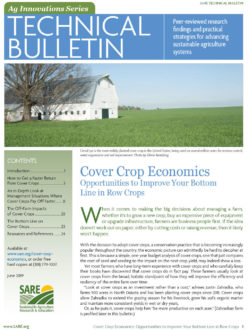Cover Crops Offer Options in Wet Soil
As more farmers across the nation begin to incorporate covers into their rotations, they find that this valuable conservation practice pays in more ways than one. Many farmers in states suffering from oversaturated fields that prevented or delayed planting are considering cover crops. To help farmers evaluate the benefits of incorporating cover crops into their production systems, USDA-SARE released an important new report that examines the big question: “When do cover crops pay?”
Cover Crop Economics: Opportunities to Improve Your Bottom Line in Row Crops is now available for free in print and for download, and is great for farmers and educators alike.
Download or order Cover Crop Economics now.
Using data gathered from five years of national cover crop surveys, Cover Crop Economics addresses the economic returns that can be expected from cover crops under various management scenarios and as cover crops improve soil health over time. This report takes a comprehensive approach by identifying seven different management situations when cover crops pay off faster. They are when:
- Herbicide-resistant weeds are a problem
- Cover crops are grazed
- Soil compaction is an issue
- Cover crops are used to speed up and ease the transition to no-till
- Soil moisture is at a deficit or irrigation is needed
- Fertilizer costs are high or manure nutrients need to be sequestered
- Incentive payments are received for using cover crops
Download or order your free print copy of Cover Crop Economics: Opportunities to Improve Your Bottom Line in Row Crops at sare.org/cover-crop-economics or by calling (301) 779-1007. Cover Crop Economics is available in quantity for free to educators for use in educational workshops, classes or tours.
